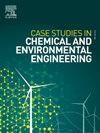Influence of pyrolysis conditions on the adsorbent properties of hazelnut shell biochar to remove paracetamol, amoxicillin, and triclosan
Q1 Environmental Science
Case Studies in Chemical and Environmental Engineering
Pub Date : 2025-06-18
DOI:10.1016/j.cscee.2025.101251
引用次数: 0
Abstract
This study optimized the production of biochar from hazelnut shells for the adsorption of paracetamol, amoxicillin, and triclosan from water. Biochar was produced under 27 conditions (temperature: 500–900 °C, time: 0.5–2 h, particle size: 150–2000 μm). Physicochemical and instrumental analyses, as well as batch adsorption tests, characterized the samples. Temperature (900 °C) is the most significant factor influencing biochar properties and adsorption performance. Adsorption data fitted well with heterogeneous isotherm models, including the Sips model and multilayer/monolayer models. The maximum adsorption capacities for paracetamol, amoxicillin, and triclosan were 19.973, 2.992, and 2.678 mg/g, respectively. Biochar-based adsorption systems with water treatment applications will be scaled.

热解条件对榛子壳生物炭对扑热息痛、阿莫西林和三氯生吸附性能的影响
本研究优化了以榛子壳为原料制备生物炭,用于吸附水中的扑热息痛、阿莫西林和三氯生。在温度500 ~ 900℃,时间0.5 ~ 2 h,粒径150 ~ 2000 μm 27种条件下制备生物炭。物理化学和仪器分析,以及批量吸附测试,表征了样品。温度(900℃)是影响生物炭性能和吸附性能的最重要因素。吸附数据与非均质等温线模型(包括Sips模型和多层/单层模型)拟合良好。对扑热息痛、阿莫西林和三氯生的最大吸附量分别为19.973、2.992和2.678 mg/g。生物炭基吸附系统与水处理应用将扩大规模。
本文章由计算机程序翻译,如有差异,请以英文原文为准。
求助全文
约1分钟内获得全文
求助全文
来源期刊

Case Studies in Chemical and Environmental Engineering
Engineering-Engineering (miscellaneous)
CiteScore
9.20
自引率
0.00%
发文量
103
审稿时长
40 days
 求助内容:
求助内容: 应助结果提醒方式:
应助结果提醒方式:


